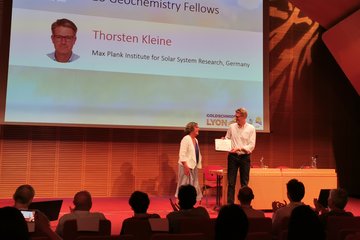Alle Typen
581.
Zeitschriftenartikel
Is solar mesogranulation a surface phenomenon? Astronomy and Astrophysics 356, S. 1050 - 1054 (2000)
582.
Zeitschriftenartikel
Reconstruction of past solar irradiance. Space Science Reviews 94, S. 127 - 138 (2000)
583.
Zeitschriftenartikel
Cyclic evolution of sunspots: Gleaning new results from old data. J. Astrophys. Astron. 21, S. 163 - 165 (2000)
584.
Zeitschriftenartikel
Evolution of the Sun's large-scale magnetic field since the Maunder minimum. Nature 408, S. 445 - 447 (2000)
585.
Zeitschriftenartikel
On the relationship between shift and intensity of ultraviolet lines in coronal holes and the quiet Sun. Astronomy and Astrophysics 362, S. L49 - L52 (2000)
586.
Zeitschriftenartikel
Comparison of far-ultraviolet emission lines formed in coronal holes and the quiet Sun. Astronomy and Astrophysics 363, S. 1145 - 1154 (2000)
587.
Zeitschriftenartikel
Modelling solar irradiance variations: Comparison with observations, including line-ratio variations. Space Science Reviews 94, S. 145 - 152 (2000)
588.
Zeitschriftenartikel
Hanle effect observations with the Ca I 4227 Å line. Astronomy and Astrophysics 350, S. 1060 - 1070 (1999)
589.
Zeitschriftenartikel
Two dimensional simulations of solar granulation: description of technique and comparison with observations. Astronomy and Astrophysics 350, S. 1018 - 1034 (1999)
590.
Zeitschriftenartikel
Intercalibration of SUMER and CDS on SOHO. I. SUMER detector A and CDS NIS. Applied Optics 38, S. 7035 - 7046 (1999)
591.
Zeitschriftenartikel
The evolution of solar granules deduced from 2-D simulations. Astronomy and Astrophysics 352, S. 679 - 696 (1999)
592.
Zeitschriftenartikel
Signatures of coronal hole spectra between 660 and 1460 Å measured with SUMER on SOHO. Space Science Reviews 87, S. 299 - 302 (1999)
593.
Zeitschriftenartikel
Is the FIP effect present inside solar photospheric magnetic flux tubes? Astronomy and Astrophysics 351, S. 701 - 706 (1999)
594.
Zeitschriftenartikel
Coronal Holes Properties Observed with SUMER. Space Science Reviews 87, S. 315 - 318 (1999)
595.
Zeitschriftenartikel
Coronal holes versus normal quiet Sun observed with SUMER. Astrophysics and Space Science 264, S. 53 - 61 (1999)
596.
Buch
Solar Magnetic Fields: from measurement towards understanding. Springer, Dordrecht (2018), 426 S.
597.
Buch
The Origin and Dynamics of Solar Magnetism. Springer, Berlin (2009), 428 S.
598.
Buch
Perspektiven der Erforschung von Sonne und Heliosphäre in Deutschland. Copernicus GmbH, Katlenburg-Lindau (2003), 46 S.
599.
Buchkapitel
The Sun's Atmosphere. In: The Sun as a Guide to Stellar Physics, S. 59 - 85 (Hg. Engvold, O.; Vial, .-C.; Skumanich, A.). Elsevier, Amsterdam (2019)
600.
Buchkapitel
Probing the Sun with ALMA: observations and simulations. In: Revolution in Astronomy with ALMA: The Third Year, Bd. 499, S. 349 - 350. Astronomical Soc Pacific, San Francisco (2015)











